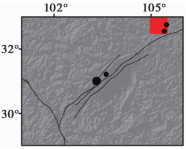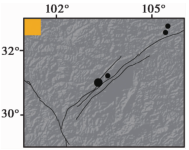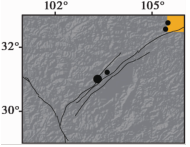地震地质 ›› 2022, Vol. 44 ›› Issue (6): 1539-1556.DOI: 10.3969/j.issn.0253-4967.2022.06.011
宋冬梅1)( ), 王慧1,2),*(
), 王慧1,2),*( ), 单新建3), 王斌1), 崔建勇1)
), 单新建3), 王斌1), 崔建勇1)
收稿日期:2021-12-29
修回日期:2022-03-21
出版日期:2022-12-20
发布日期:2023-01-21
通讯作者:
王慧
作者简介:宋冬梅, 女, 1973年生, 2003年于中国科学院沈阳应用生态研究所获理学博士学位, 教授, 主要研究方向为地震重力异常信息提取, E-mail: songdongmei@upc.edu.cn。
基金资助:
SONG Dong-mei1)( ), WANG Hui1,2),*(
), WANG Hui1,2),*( ), SHAN Xin-jian3), WANG Bin1), CUI Jian-yong1)
), SHAN Xin-jian3), WANG Bin1), CUI Jian-yong1)
Received:2021-12-29
Revised:2022-03-21
Online:2022-12-20
Published:2023-01-21
Contact:
WANG Hui
摘要:
地震的发生与地壳构造运动密切相关, 而地壳构造运动会造成地下介质密度的改变, 从而导致地球重力场发生变化。GRACE重力卫星所提供的全球时变重力场数据可用于发现大地震的震前重力异常。然而, GRACE数据中存在的南北条带噪声严重干扰震前异常信息的提取。目前常用的高斯滤波等处理方法在抑制噪声的同时, 也削弱了有价值的重力异常信号。为此, 文中提出了一种基于最大切应变的震前重力异常信息提取方法。该方法通过计算扰动引力位的2阶梯度对南北条带噪声进行压制, 并基于地壳形变理论得到最大切应变以获取重力的变化信息。最后, 利用最大切应变的偏移指数K进一步探究震前重力异常的时空演变规律。文中以汶川地震和尼泊尔地震为例, 采用上述方法完成震前重力异常信息提取, 并进行了断裂带的震前构造活动分析。结果显示, 在震前半年内, 发震断裂带上出现了与断裂带空间展布一致的大面积重力异常区, 且最大异常值出现在震中距50km范围内, 而在非震期并未出现异常现象。此外, 经分析发现, 与传统方法相比, 本文方法对重力场的异常信息提取能力更强, 这为利用GRACE数据认识大地震的动力机制提供了新思路。
中图分类号:
宋冬梅, 王慧, 单新建, 王斌, 崔建勇. 基于最大切应变的震前GRACE重力异常信息提取方法[J]. 地震地质, 2022, 44(6): 1539-1556.
SONG Dong-mei, WANG Hui, SHAN Xin-jian, WANG Bin, CUI Jian-yong. A NOVEL EXTRACTION METHOD OF PRE-EARTHQUAKE GRACE GRAVITY ANOMALY INFORMATION BASED ON MAXIMUM SHEAR STRAIN[J]. SEISMOLOGY AND GEOLOGY, 2022, 44(6): 1539-1556.

图 1 龙门山断裂带(黄色矩形框①)和南喜马拉雅造山带(黄色矩形框②)在青藏高原上的位置 F1喜马拉雅主冲带; F2喀喇昆仑-嘉里断裂带; F3玛尼-玉树-鲜水河断裂带; F4昆仑-玛沁断裂带; F5阿尔金-海原断裂带; F6金沙江-红河断裂带。上述断裂带将青藏高原划分为6个不同的活动块体(Taylor et al., 2009), 分别为拉萨块体 (B1)、 羌塘块体(B2)、 巴颜喀拉块体(B3)、 柴达木块体(B4)、 祁连块体(B5)和川滇块体(B6)
Fig. 1 The location of the Longmenshan fault zone(yellow rectangle ①) and the southern Himalayan orogenic belt(yellow rectangle ②)in Tibetan plateau.
| 发震断裂带 | 发震日期(UTC) | 震级 | 震中位置 | 震源深度/km | |
|---|---|---|---|---|---|
| 东经/(°) | 北纬/(°) | ||||
| 龙门山断裂带 | 2008-05-12 | MW7.9 | 103.322 | 31.002 | 19.0 |
| 2008-05-12 | MW6.1 | 103.618 | 31.214 | 10.0 | |
| 2008-05-25 | MW6.1 | 105.423 | 32.56 | 18.0 | |
| 2008-08-05 | MW6.0 | 105.494 | 32.756 | 6.0 | |
| 喜马拉雅造山带 | 2015-04-25 | MW7.8 | 84.731 | 28.231 | 8.2 |
| 2015-04-25 | MW6.1 | 85.540 | 27.629 | 10.0 | |
| 2015-04-25 | MW6.6 | 84.822 | 28.224 | 10.0 | |
| 2015-04-26 | MW6.7 | 86.017 | 27.771 | 22.9 | |
| 2015-05-12 | MW7.3 | 86.066 | 27.809 | 15.0 | |
| 2015-05-12 | MW6.3 | 86.162 | 27.625 | 15.0 |
表1 本研究中各震例的详细信息(数据来源: USGS官网)
Table1 Details of each earthquake case involved in this study(data source: USGS)
| 发震断裂带 | 发震日期(UTC) | 震级 | 震中位置 | 震源深度/km | |
|---|---|---|---|---|---|
| 东经/(°) | 北纬/(°) | ||||
| 龙门山断裂带 | 2008-05-12 | MW7.9 | 103.322 | 31.002 | 19.0 |
| 2008-05-12 | MW6.1 | 103.618 | 31.214 | 10.0 | |
| 2008-05-25 | MW6.1 | 105.423 | 32.56 | 18.0 | |
| 2008-08-05 | MW6.0 | 105.494 | 32.756 | 6.0 | |
| 喜马拉雅造山带 | 2015-04-25 | MW7.8 | 84.731 | 28.231 | 8.2 |
| 2015-04-25 | MW6.1 | 85.540 | 27.629 | 10.0 | |
| 2015-04-25 | MW6.6 | 84.822 | 28.224 | 10.0 | |
| 2015-04-26 | MW6.7 | 86.017 | 27.771 | 22.9 | |
| 2015-05-12 | MW7.3 | 86.066 | 27.809 | 15.0 | |
| 2015-05-12 | MW6.3 | 86.162 | 27.625 | 15.0 |

图 3 龙门山断裂带上震前2a的重力异常值总和 红色虚线表示 MW7.9 汶川地震的发震时间
Fig. 3 The sum of gravity anomalies on the Longmenshan fault zone two years before the Wenchuan earthquake.

图 4 龙门山断裂带的偏移指数K在震前的时空变化结果 该图像的像素是对去除水文影响后的扰动引力位进行插值所得的0.5°×0.5°的结果。 图幅中的最大值位于紫色矩形框所在位置。红色标注日期为发震期, 红色圆点表示发震位置
Fig. 4 Pre-earthquake spatio-temporal variation of the offset index K on the Longmenshan fault zone.

图 5 龙门山断裂带在非震年份的同期偏移指数K的时空变化结果 图中圆点的含义与图 4 一致
Fig. 5 Temporal and spatial variation results of the simultaneous offset index K of the Longmenshan fault zone in non-earthquake years.

图 6 南喜马拉雅造山带上震前2a的重力异常值总和 红色虚线表示 MW7.8 尼泊尔地震的发震时间
Fig. 6 The sum of gravity anomalies in the southern Himalayan orogenic belt two years before the MW7.8 Nepal earthquake.

图 7 南喜马拉雅造山带上的偏移指数K的震前时空变化结果 标注*的时间段内存在GRACE原始数据缺失的现象, 即无2014年12月的GRACE数据
Fig. 7 Pre-earthquake spatio-temporal variation of the offset index Kin the southern Himalayan orogenic belt.

图 8 南喜马拉雅造山带在非震年份的同期偏移指数K的时空变化结果 图中圆点的含义与图 7 一致
Fig. 8 Temporal and spatial variation results of the simultaneous offset index K of the southern Himalayan orogenic belt in non-earthquake years.

图 9 汶川地震前2a龙门山断裂带上最大切应变和扰动位的K值时间序列 a 基于最大切应变震前2a的时间序列计算的龙门山断裂带区域里所有像素的K值(K>1、 2、 3)总和。b-d 基于重力值本身(相邻月份扰动位增量)在震前2a的时间序列计算的龙门山断裂带区域里所有像素的K值(K>1、 2、 3)总和, 其各自对应的高斯滤波平滑半径分别为250km、 300km和500km。图中红色箭头表示汶川地震的发震时间。由于K值是由GRACE卫星的3个相邻月重力场数据计算得到, 为了便于表示, 在图中的时间坐标轴上仅标注这3个月中最后1个月的时间
Fig. 9 Total K value of maximum shear strain and disturbance potential in the Longmenshan fault zone two years before the Wenchuan earthquake.
| 本文方法 | 经典方法 | |||
|---|---|---|---|---|
| 最大切应变 | 高斯滤波R=250km | 高斯滤波R=300km | 高斯滤波R=500km | |
| 最大K值 | 4.6 | 3.4 | 2.8 | 2.8 |
| 出现时间 | 震前3个月内 | 震前2a | 震前2a | 震前1a |
| 出现位置 |  |  |  |  |
| 105°~105.5°N, 32.5°~33°E | 101°~101.5°N, 32.5°~33°E | 101°~101.5°N, 32.5°~33°E | 105.5°~106°N, 32.5°~33°E | |
表2 震前2a最大切应变和扰动位时间序列中各自的最大K值
Table2 Maximum K value in the time series of maximum shear strain and disturbance potential two years before the Wenchuan earthquake
| 本文方法 | 经典方法 | |||
|---|---|---|---|---|
| 最大切应变 | 高斯滤波R=250km | 高斯滤波R=300km | 高斯滤波R=500km | |
| 最大K值 | 4.6 | 3.4 | 2.8 | 2.8 |
| 出现时间 | 震前3个月内 | 震前2a | 震前2a | 震前1a |
| 出现位置 |  |  |  |  |
| 105°~105.5°N, 32.5°~33°E | 101°~101.5°N, 32.5°~33°E | 101°~101.5°N, 32.5°~33°E | 105.5°~106°N, 32.5°~33°E | |
| [1] | 丁一航, 黄丁发, 师悦龄, 等. 2018. 利用GPS和GRACE分析四川地表垂向位移变化[J]. 地球物理学报, 61(12): 4777-4788. |
| DING Yi-hang, HUANG Ding-fa, SHI Yue-ling, et al. 2018. Determination of vertical surface displacements in Sichuan using GPS and GRACE measurements[J]. Chinese Journal of Geophysics, 61(12): 4777-4788. (in Chinese) | |
| [2] | 范一大, 吴玮, 王薇, 等. 2016. 中国灾害遥感研究进展[J]. 遥感学报, 20(5): 1170-1184. |
| FAN Yi-da, WU Wei, WANG Wei, et al. 2016. Research progress of disaster remote sensing in China[J]. Journal of Remote Sensing, 20(5): 1170-1184. (in Chinese) | |
| [3] | 郭飞霄, 孙中苗, 汪菲菲, 等. 2018. GRACE卫星时变重力场滤波方法研究进展[J]. 地球物理学进展, 33(5): 1783-1788. |
| GUO Fei-xiao, SUN Zhong-miao, WANG Fei-fei, et al. 2018. Review of GRACE satellites time-variable gravity filtering methods[J]. Progress in Geophysics, 33(5): 1783-1788. (in Chinese) | |
| [4] | 李光强. 2009. 时空异常探测理论与方法[D]. 长沙: 中南大学:1-142. |
| LI Guang-qiang. 2009. Theories and methods of spatio-temporal outliers detection[D]. Central South University, Changsha: 1-142 (in Chinese) | |
| [5] | 李吉均, 方小敏. 1998. 青藏高原隆起与环境变化研究[J]. 科学通报, 43(15): 1569-1574. |
| LI Ji-jun, FANG Xiao-min. 1998. Study on Tibetan plateau uplift and environmental change[J]. Chinese Science Bulletin, 43(15): 1569-1574. (in Chinese) | |
| [6] | 刘潇. 2021. 小波多尺度分析尼泊尔 MW7.8 地震前卫星重力变化[J]. 华南地震, 41(1): 73-77. |
| LIU Xiao. 2021. Wavelet multi scale analysis of satellite gravity changes before Nepal MW7.8 earthquake[J]. South China Journal of Seismology, 41(1): 73-77. (in Chinese) | |
| [7] | 彭令, 徐素宁, 梅军军, 等. 2017. 地震滑坡高分辨率遥感影像识别[J]. 遥感学报, 21(4): 509-518. |
| PENG Ling, XU Su-ning, MEI Jun-jun, et al. 2017. Earthquake-induced landslide recognition using high-resolution remote sensing images[J]. Journal of Remote Sensing, 21(4): 509-518. (in Chinese) | |
| [8] |
单新建, 屈春燕, 郭利民, 等. 2014. 基于InSAR与GPS观测的汶川同震垂直形变场的获取[J]. 地震地质, 36(3): 718-730. doi: 10.3969/j.issn.0253-4967.2014.03.014.
DOI |
| SHAN Xin-jian, QU Chun-yan, GUO Li-min, et al. 2014. The vertical coseismic deformation field of the Wenchuan earthquake based on the combination of GPS and INSAR measurements[J]. Seismology and Geology, 36(3): 718-730. (in Chinese) | |
| [9] | 申俊, 刘敬华, 左天惠. 2018. 浅谈地震台站监测设施和观测环境保护[J]. 高原地震, 30(1): 69-72. |
| SHEN Jun, LIU Jing-hua, ZUO Tian-hui.2018. Discussion on the protection of facilities in seismic stations and observation environment[J]. Plateau Earthquake Research, 30(1): 69-72. (in Chinese) | |
| [10] | 孙闯. 2017. 龙门山褶皱冲断带构造物理模拟研究[D]. 南京: 南京大学:1-135. |
| SUN Chuang. 2017. Physical modeling of the Longmenshan fold and thrust belt[D]. Nanjing University, Nanjing: 1-135 (in Chinese) | |
| [11] | 王陈燕, 游为, 范东明. 2019. 利用独立成分分析检测2004年和2012年印度洋地震的重力变化[J]. 地球物理学报, 62(11): 4142-4155. |
| WANG Chen-yan, YOU Wei, FAN Dong-ming. 2019. Using independent component analysis to detect the gravity changes in the Indian Ocean earthquakes of 2004 and 2012[J]. Chinese Journal of Geophysics, 62(11): 4142-4155. (in Chinese) | |
| [12] |
王武星, 顾国华, 陈石. 2014. 利用GRACE观测资料分析日本 MW9.0 地震前区域重力变化特征[J]. 地震地质, 36(2): 523-535. doi: 10.3969/j.issn.0253-4967.2014.02.020.
DOI |
| WANG Wu-xing, GU Guo-hua, CHEN Shi. 2014. Study on regional gravity changes before the MW9.0 Japan earthquake detected by GRACE[J]. Seismology and Geology, 36(2): 523-535. (in Chinese) | |
| [13] | 许才军, 申文斌, 晁定波. 2006. 地球物理大地测量学原理与方法[M]. 武汉: 武汉大学出版社:193-209. |
| XU Cai-jun, SHEN Wen-bin, CHAO Ding-bo. 2006. Geophysical Geodesy Principles and Methods[M]. Wuhan University Press, Wuhan: 193-209 (in Chinese) | |
| [14] | 徐锡伟, 陈桂华, 王启欣, 等. 2017. 九寨沟地震发震断层属性及青藏高原东南缘现今应变状态讨论[J]. 地球物理学报, 60(10): 4018-4026. |
| XU Xi-wei, CHEN Gui-hua, WANG Qi-xin, et al. 2017. Discussion on seismogenic structure of Jiuzhaigou earthquake and its implication for current strain state in the southeastern Qinghai-Tibet Plateau[J]. Chinese Journal of Geophysics, 60(10): 4018-4026. (in Chinese) | |
| [15] | 张培震, 邓起东, 张国民, 等. 2003. 中国大陆的强震活动与活动地块[J]. 中国科学(D辑), 33(S1): 12-20. |
| ZHANG Pei-zhen, DENG Qi-dong, ZHANG Guo-min, et al. 2003. Active tectonic blocks and strong earthquakes in the continent of China[J]. Science in China(Ser D), 33(S1): 12-20. (in Chinese) | |
| [16] |
Allen R M, Melgar D. 2019. Earthquake early warning: Advances, scientific challenges, and societal needs[J]. Annual Review of Earth and Planetary Sciences, 47(1): 361-388.
DOI URL |
| [17] |
Baik H, Son Y S, Kim K E. 2019. Detection of liquefaction phenomena from the 2017 Pohang(Korea)earthquake using remote sensing data[J]. Remote Sensing, 11(18): 2184.
DOI URL |
| [18] |
Burg J P, Davy P, Nievergelt P, et al. 1997. Exhumation during crustal folding in the Namche-Barwa syntaxis[J]. Terra Nova, 9(2): 53-56.
DOI URL |
| [19] |
Chao B F, Liau J R. 2019. Gravity changes due to large earthquakes detected in GRACE satellite data via empirical orthogonal function analysis[J]. Journal of Geophysical Research: Solid Earth, 124(3): 3024-3035.
DOI |
| [20] | Cheng M, Tapley B D. 2004. Variations in the Earth’s oblateness during the past 28 years[J]. Journal of Geophysical Research: Solid Earth, 109(B9): B09402. |
| [21] | Cui J, Li P, Li L. 2001. Uplift of the Qinghai-Tibet Plateau: Lithospheric structure and structural geomorphology of the Qinghai-Tibet Plateau[J]. Continental Dynamics, 6(2): 29-37. |
| [22] |
Dai C L, Shum C K, Guo J Y, et al. 2016. Improved source parameter constraints for five undersea earthquakes from north component of GRACE gravity and gravity gradient change measurements[J]. Earth and Planetary Science Letters, 443: 118-128.
DOI URL |
| [23] |
Deggim S, Eicker A, Schawohl L, et al. 2021. RECOG RL01: Correcting GRACE total water storage estimates for global lakes/reservoirs and earthquakes[J]. Earth System Science Data, 13(5): 2227-2244.
DOI URL |
| [24] |
Dermanis A, Livireratos E. 1983. Applications of deformation analysis in geodesy and geodynamics[J]. Reviews of Geophysics and Space Physics, 21(1): 41-50.
DOI URL |
| [25] |
Dirks P, Wilson C J L, Chen S, et al. 1994. Tectonic evolution of the NE margin of the Tibetan plateau: Evidence from the central Longmen Mountains, Sichuan Province, China[J]. Journal of Southeast Asian Earth Sciences, 9(1-2): 181-192.
DOI URL |
| [26] |
Eshagh M, Abdollahzadeh M. 2012. Software for generating gravity gradients using a geopotential model based on an irregular semivectorization algorithm[J]. Computers and Geosciences, 39: 152-160.
DOI URL |
| [27] |
Fan X, Scaringi G, Korup O, et al. 2019. Earthquake-induced chains of geologic hazards: Patterns, mechanisms, and impact[J]. Reviews of Geophysics, 57(2): 421-503.
DOI URL |
| [28] |
Fatolazadeh F, Goïta K, Javadi Azar R. 2020. Determination of earthquake epicentres based upon invariant quantities of GRACE strain gravity tensors[J]. Scientific Reports, 10(1): 1-14.
DOI URL |
| [29] |
Gu Y, Yuan L, Fan D, et al. 2017. Seasonal crustal vertical deformation induced by environmental mass loading in mainland China derived from GPS, GRACE and surface loading models[J]. Advances in Space Research, 59(1): 88-102.
DOI URL |
| [30] |
Han S C, Shum C K, Bevis M, et al. 2006. Crustal dilatation observed by GRACE after the 2004 Sumatra-Andaman earthquake[J]. Science, 313(5787): 658-662.
DOI URL |
| [31] | Hasegawa T, Fukuda Y, Shum C K. 2011. Effects of Gaussian filter in processing GRACE data: Gravity rate of change at Lhasa, southern Tibet[J]. Science China(Earth Sciences), 54(9): 1378-1385. |
| [32] |
Ince E S, Barthelmes F, Reiβland S, et al. 2019. ICGEM -15 years of successful collection and distribution of global gravitational models, associated services, and future plans[J]. Earth System Science Data, 11(2): 647-674.
DOI URL |
| [33] | Jiao Z H, Zhao J, Shan X. 2018. Pre-seismic anomalies from optical satellite observations: A review[J]. Natural Hazards and Earth System Sciences, 18(4): 1013-1036. |
| [34] |
Klees R, Koop R, Visser P, et al. 2000. Efficient gravity field recovery from GOCE gravity gradient observations[J]. Journal of geodesy, 74(7): 561-571.
DOI URL |
| [35] |
Li J, Shen W B. 2015. Monthly GRACE detection of coseismic gravity change associated with 2011 Tohoku-Oki earthquake using northern gradient approach[J]. Earth, Planets and Space, 67(1): 1-11.
DOI URL |
| [36] |
Massonnet D, Feigl K, Rossi M, et al. 1994. Radar interferometric mapping of deformation in the year after the Landers earthquake[J]. Nature, 369(6477): 227-230.
DOI URL |
| [37] |
Pavel F, Vacareanu R. 2017. Ground motion simulations for seismic stations in southern and eastern Romania and seismic hazard assessment[J]. Journal of Seismology, 21(5): 1023-1037.
DOI URL |
| [38] |
Peidou A, Pagiatakis S. 2019. Gravity gradiometry with GRACE space missions: New opportunities for the geosciences[J]. Journal of Geophysical Research: Solid Earth, 124(8): 9130-9147.
DOI |
| [39] | Peidou A, Pagiatakis S. 2020. Stripe mystery in GRACE geopotential models revealed[J]. Geophysical Research Letters, 47(4): e2019GL085497. |
| [40] |
Piscini A, Santis A, Marchetti D, et al. 2017. A multi-parametric climatological approach to study the 2016 Amatrice-Norcia(central Italy)earthquake preparatory phase[J]. Pure and Applied Geophysics, 174(10): 3673-3688.
DOI URL |
| [41] |
Spennemann P C, Rivera J A, Saulo A C, et al. 2015. A comparison of GLDAS soil moisture anomalies against standardized precipitation index and multisatellite estimations over South America[J]. Journal of Hydrometeorology, 16(1): 158-171.
DOI URL |
| [42] | Sun H, Xu J, Cui X. 2017. Research progress of the gravity field application in Earth’s geodynamics and interior structure[J]. Acta Geodaetica et Cartographica Sinica, 46(10): 1290-1299. |
| [43] | Sun W, Okubo S. 2004. Coseismic deformations detectable by satellite gravity missions: A case study of Alaska(1964, 2002)and Hokkaido(2003)earthquakes in the spectral domain[J]. Journal of Geophysical Research: Solid Earth, 109(B4): B04405. |
| [44] | Swenson S, Chambers D, Wahr J. 2008. Estimating geocenter variations from a combination of GRACE and ocean model output[J]. Journal of Geophysical Research: Solid Earth, 113(B8): B08410. |
| [45] | Tan C, Zhang P, Lu S, et al. 2019. Significance and role of in-situ crustal stress measuring and real-time monitoring in earthquake prediction research[J]. Journal of Geomechanics, 25(5): 866-876. |
| [46] |
Taylor M, Yin A. 2009. Active structures of the Himalayan-Tibetan orogen and their relationships to earthquake distribution, contemporary strain field, and Cenozoic volcanism[J]. Geosphere, 5(3): 199-214.
DOI URL |
| [47] | Velicogna I, Mohajerani Y A G, Landerer F, et al. 2020. Continuity of ice sheetmass loss in Greenland and Antarctica from the GRACE and GRACE Follow-on missions[J]. Geophysical Research Letters, 47(8): e2020GL087291. |
| [48] |
Wahr J, Molenaar M, Bryan F. 1998. Time variability of the Earth’s gravity field: Hydrological and oceanic effects and their possible detection using GRACE[J]. Journal of Geophysical Research, 103(B12): 30205-30230.
DOI URL |
| [49] |
Xu X, Wen X, Yu G, et al. 2009. Coseismic reverse- and oblique-slip surface faulting generated by the 2008 MW7.9 Wenchuan earthquake, China[J]. Geology, 37(6): 515-518.
DOI URL |
| [50] |
Zhang Y, Feng W P, Xu L S, et al. 2009. Spatio-temporal rupture process of the 2008 great Wenchuan earthquake[J]. Science in China(Ser D), 52(2): 145-154.
DOI URL |
| [51] |
Zhao Q, Wu Y, Wu W. 2015. Effectiveness of empirical orthogonal function used in decorrelation of GRACE time-variable gravity field[J]. Geodesy and Geodynamics, 6(5): 324-332.
DOI URL |
| [52] |
Zhao X, Pan S, Sun Z, et al. 2021. Advances of satellite remote sensing technology in earthquake prediction[J]. Natural Hazards Review, 22(1): 03120001.
DOI URL |
| [53] |
Zieger T, Ritter J R R. 2018. Influence of wind turbines on seismic stations in the upper Rhine graben, SW Germany[J]. Journal of Seismology, 22(1): 105-122.
DOI URL |
| [1] | 王晓山, 万永革. 汶川地震前震中周围地壳应力场及应力方向集中的特征[J]. 地震地质, 2022, 44(2): 363-377. |
| [2] | 郭树松, 祝意青, 徐云马, 刘芳, 赵云峰, 张国庆, 朱辉. 汶川地震前失稳过程的重力场观测证据[J]. 地震地质, 2021, 43(6): 1368-1380. |
| [3] | 兰剑, 陈晓利. 2008年MS8.0汶川地震诱发滑坡灾害在映秀地区的演化特征[J]. 地震地质, 2020, 42(1): 125-146. |
| [4] | 朱传华, 单新建, 张国宏, 焦中虎, 张迎峰, 李彦川, 乔鑫. 汶川地震热异常与构造应力关联的数值模拟[J]. 地震地质, 2019, 41(6): 1497-1510. |
| [5] | 宋冬梅, 向亮, 单新建, 尹京苑, 王斌, 崔建勇. 基于SVR模型的电离层TEC背景场构建方法[J]. 地震地质, 2019, 41(6): 1511-1528. |
| [6] | 马思远, 许冲, 王涛, 刘甲美. 应用2类Newmark简易模型进行2008年汶川地震滑坡评估[J]. 地震地质, 2019, 41(3): 774-788. |
| [7] | 徐志萍, 王夫运, 姜磊, 赵延娜, 杨利普, 唐淋. 龙门山中南段地壳上地幔三维密度结构[J]. 地震地质, 2019, 41(1): 84-98. |
| [8] | 尹得余, 刘启方, 刘畅, 季鑫洋. 基于近场强震记录和同震位移的汶川地震破裂过程[J]. 地震地质, 2018, 40(3): 698-717. |
| [9] | 赵由佳, 张国宏, 张迎峰, 单新建, 屈春燕. 基于连续-离散单元法的汶川地震动力学二维自发破裂全周期模拟研究[J]. 地震地质, 2018, 40(1): 12-26. |
| [10] | 万永革, 靳志同, 崔华伟, 黄骥超, 李瑶, 李祥. 2015年尼泊尔强震序列导致的喜马拉雅山峰位移场[J]. 地震地质, 2017, 39(4): 699-711. |
| [11] | 刘远征, 马瑾, 马文涛, 姜彤. 探讨水头增量及其变化率对水库诱发地震活动的影响-以紫坪铺水库为例[J]. 地震地质, 2017, 39(3): 437-450. |
| [12] | 姚路, 马胜利, 王羽, 何宏林, 陈建业, 杨晓松, 嶋本利彦. 汶川地震断层岩的镜质体反射率——对断层同震摩擦滑动性质的约束[J]. 地震地质, 2016, 38(4): 817-829. |
| [13] | 魏本勇, 苏桂武. 基于投入产出分析的汶川地震灾害间接经济损失评估[J]. 地震地质, 2016, 38(4): 1082-1094. |
| [14] | 江颖, 刘子维, 李辉, 张晓彤, 韦进, 申重阳. 基于连续重力观测约束2015年尼泊尔地震的震源机制解[J]. 地震地质, 2016, 38(3): 660-669. |
| [15] | 宋冬梅, 臧琳, 单新建, 袁媛, 崔建勇, 邵红梅, 沈晨, 时洪涛. 基于LST年趋势背景场的地震热异常提取算法[J]. 地震地质, 2016, 38(3): 680-695. |
| 阅读次数 | ||||||
|
全文 |
|
|||||
|
摘要 |
|
|||||